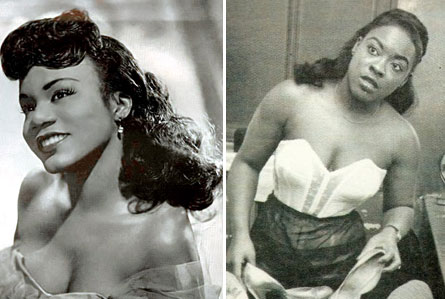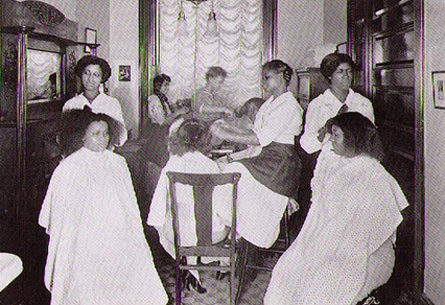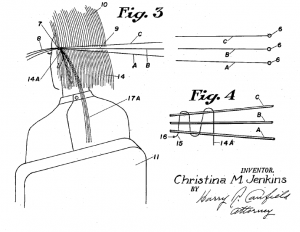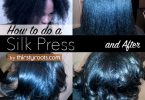
Pictured Above: (Left) 1950s Ballad Singer Bette Mclaurin (Right) Unknown
Who invented the weave for hair and in what year? That is a question that has been burning in a lot of peoples heads. We love the ability to change our look at the drop of a dime if we wish. It was a great invention and we are thankful for it. Going from a short curly do to a long wavy sexy do all in one day is every woman’s dream.
Well an African American lady by the name of Christina Jenkins invented the hair weaving process in the nineteen fifties. She received a patent in 1951 for this process of hair weaving. Although people were wearing wigs and hair pieces for thousands of years, Christina came up with the weaving idea. She was married to a jazz musician named Duke at the time and lived in Cleveland Ohio.
Christina and Duke Jenkins formed their company Christina’s Hair-Weev in the early nineteen fifties. People were so in love with her weaves and method of applying them that they would pay her to come to their countries and teach them how to sew in hair weave. Before she invented the idea to sew the weave onto the hair, people were putting the weave on with hair pins placed on the scalp.

New York branch of Lelia College (Madame C.J. Walker founded the college in Pittsburgh in 1908 to train African American as “hair culturist”, expanding to branches nationwide) – Museum of the City of New York, The Byron Collection.
Hair weaves back in those days were stiff and pretty bulky. Mrs. Jenkins technique at first looked the same once done. What she did for the hair extension world was created a way for it to be applied and stay for a while. Her technique at that time was very time consuming. In the nineteen fifties the way she would do a weave sew in, according to the patent includes:
…connecting successive strands of live hair and successive strands of commercial hair to a linearly elongated attachment base of cord-like material at closely spaced points therealong.
…interweaving strands of live hair and strands of commercial hair, with cord like material to permanently join the strands thereto.
…interweaving strands of live hair with filamentous material to permanently secure the filamentous material as a base on the head; and attaching a switch or like accessory of commercial hair to the base, by thread.
etc.
Patent US 2621663 – Permanently attaching commercial hair to live hair: US2621663

Diagram from Christina Jenkins 1951 issued patent
Christina Jenkins maiden name is Thomas and she was born in Louisiana. She graduated from Leland College in nineteen forty three. That same year is when she married well known Jazz Pianist Herman Duke Jenkins. Sadly she passed away in December of 2003.
Now you know who invented the weave for hair and in what year. In December think of her as well and give thanks as you wear that cute weave you have on your head. Mrs. Christina Jenkins has done a great service to us all by inventing a way for us to turn our short locks into long ones without damaging our natural hair.
Resources:
Congressional Record: Volume 149, Part 23 By Bernan
Encyclopedia of Hair: A Cultural History By Victoria Sherrow
Hair Story: Untangling the Roots of Black Hair in America By Ayana Byrd, Lori Tharps







Are both pictures above a picture of Mrs Jenkins?
Is the lady in the above picute the same person?
“people were putting the weave on with pins placed on the scalp” pins on the scalp? what? that would have been horribly painful. Cant bare to think of it, must have been like a torture ceremony to have that on.
Duhhhnh… If you read it…It says who is who
…. Spelll this for me COMMON SENSE
OMG…. Please stop acting like y’all can’t read…🙅🙇😒
I think the reason most ppl are confused with the pictures is that they are irrelevant to the article altogether. The author of the article should have just put a caption under the pictures saying..”The weave technique in the 40’s” or something like that. Its confusing because they speak of Ms Jenkins but didn’t show her picture.
They probably were referring to bobby pins…geesh! Nobody is that daft to use actual pins. And if they did use pins it was anchored from the braids on the scalp thru the weave like when u stitch clothes before u sew them.
It’s unnecessary to respond that way, You could simply refer the reader to the pictures commentary. Sometimes the human eye simply misses details. That’s all, be peaceful and kind to one another.
This is awesome knowledge without even know what this person looks like.
This woman was smart, educated, and businessminded. I love the drive of this black woman. My pioneer in my hairstyling life.
I think her technique in today’s society is very educational. Also, I believe the author is referring to the pins as bobby-pins
I am Christina’s niece. I have pictures of her if anyone would like to reach out. The picture above is always associated with her, but it is not her. The rest of the information is true and correct. My Aunt Chris had vision beyond belief! My mother, her sister – Rose (Thomas) West and my sister Sheryl Mitchell, as well as other family members, carry out her legacy and still do hair weev’s as taught by Christina.